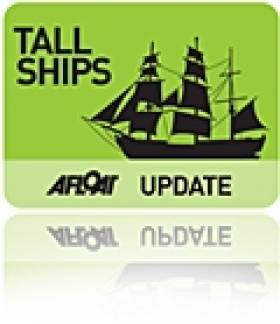Displaying items by tag: Sean Flood
Sean Flood 1932-2023
The life story of Sean Flood, who has died at the age of 91, is in many ways the story of modern Ireland as seen through a sailing and business lens. From a family of traditionally and strongly patriotic outlook, his life of many interests and sustained enthusiasms was one of a developing and positive view of the opportunities that the newly independent state presented.
He emerged from an intense background in which father’s brother, Frank Flood, had been one of the “Forgotten Ten” associated with Kevin Barry, all of whom had been executed by British forces following hasty Courts Martial during the War of Independence in 1920-21. And in more modern times during the Troubles of 1969-1998, he would have been one of the victims of the May 1974 Dublin street bombings, had he not stopped near his office in Nassau Street for a few minutes to exchange greetings and gossip in typical style with an old friend.
BREADTH OF VISION
But far from being narrow-minded through inherited outlook and close-call personal experiences, he had generous breadth of vision, and was keenly involved in the many aspects of Irish life that facilitated his enthusiastic approach, whether it was through business, sport, the encouragement of youth, or the fostering of truly all-Ireland and international friendships, while always maintaining the vital role of family life.
Yet although he was involved in the detailed administration of numerous activities in Ireland right up to the highest level, he was no armchair sportsman. On the contrary, as a highly-organised person of notable fitness, he enjoyed nothing more than being in the thick of sporting contests. And it was ultimately through sailing that he found his greatest means of personal expression, as it provided the technical challenges of boat maintenance to his perfectionist standards, together with development and tuning allied to the physical and intellectual demands of racing.
 Sean Flood as a First Lieutenant in the Naval Reserve (the Slui Muiri) in 1962 at the helm of the recently-acquired Asgard of Erskine & Molly Childers fame, when he was trying to persuade the Naval Service to take on this vessel as a sailing training ship. In time, he would become a member of Coste an Asgard, and Sail Training Ireland in addition to being an ambassador for International Sail Training
Sean Flood as a First Lieutenant in the Naval Reserve (the Slui Muiri) in 1962 at the helm of the recently-acquired Asgard of Erskine & Molly Childers fame, when he was trying to persuade the Naval Service to take on this vessel as a sailing training ship. In time, he would become a member of Coste an Asgard, and Sail Training Ireland in addition to being an ambassador for International Sail Training
It suited, too, that as a high-octane socialiser himself, all of this sport was then followed by the high levels of après sailing conviviality among competitors who may have been at each other’s throats afloat, but were immediately the very best of friends again when ashore.
A HOME IN CLONTARF
His early childhood was peripatetic, as his father was a founding member of An Garda Siochana, posted sometimes to provincial stations. Thus Sean was born in 1932 in Mullingar. But Flood Senr’s appointment as the Inspector in charge of the increasingly important Clontarf Barracks provided the family with a more settled life in leafy Clontarf, and in time when the young Sean went to school at Belvedere, it was in keeping with a family tradition which now spans four generations.
SUMMER HOLIDAYS ON CORK HARBOUR
Another tradition was the annual family summer holiday at the then-quiet village of Whitegate on the east shores of Cork Harbour. This sharpened his developing interest in the sea and shipping, sailing and seafaring, while beginning friendships which in time included fellow boat enthusiasts from all parts of Cork Harbour. Some of them may have had fully-fledged sailing dinghies to inspire the “Whitegate fleet”, who often made do with rowing dinghies fitted with any sorts of sails they could contrive until Sean got himself introduced to the Crosshaven T-Class dinghies.
NAVAL RESERVE INSTEAD OF OCEAN LINERS
However, his interest in seafaring went much deeper than that, as he hoped to make his career in ocean liners or the merchant marine. But his parents diverted this by allowing him to join the Slui Muiri – the Naval Reserve - at the age of 17 in 1949, maybe the youngest-ever recruit, and he rose through the ranks to become a First Lieutenant in 1955.
Meanwhile his father was alert to the possibilities of suggesting an alternative career which would offer his energetic son attractive work opportunities ashore, and he succeeded in this when Sean found himself - at a very young age - in the role of founding Managing Director of the new security firm of Chubb Ireland, a role he was to fill for forty years.
BUSINESS LIFE
This drew him into Dublin’s national and international business life in a highly involved way. With his perfectly-located city-centre office overlooking the College Park of TCD, he was very active in the historic Dublin Chamber of Commerce which dates its origins back to the voyage of the Ouzel Galley from Dublin to the Levant in 1695-1705. He served as Chairman of three DCC committees, and was also in direct inaugural involvement with the recently-formed Institute of Directors. And in time, he brought his company to the level where he could persuade Lord “Call me Michael” Killanin - already a towering presence in the International Olympic movement – to become the company’s chairman in Ireland.
 The show is on the road. Sean Flood (left), for forty years MD of Chubb Ireland, with his chairman Lord Killanin and Derry O’Brien, Commodore Royal St George YC, at the launching of the Chubb sponsorship of ISORA Week 1980 in Dublin Bay in 1980
The show is on the road. Sean Flood (left), for forty years MD of Chubb Ireland, with his chairman Lord Killanin and Derry O’Brien, Commodore Royal St George YC, at the launching of the Chubb sponsorship of ISORA Week 1980 in Dublin Bay in 1980
In sailing, he had been a member of the 1875-founded Clontarf Yacht & Boat Club since 1953, and in 1959 he became one of the club's youngest Commodores at the age of 27. By this time, he was very successfully racing his second IDRA 14, the turbo-powered Miss Betty bought from lifelong friend Clayton Love Jnr of Cork, and he served for many years on the Council of the Irish Dinghy Racing Association, continuing in that role when it became the Irish Yachting Association in the early 1960s.
 First major sailing success – racing the IDRA 14 Miss Betty to be Irish National Champion in 1958 and 1959
First major sailing success – racing the IDRA 14 Miss Betty to be Irish National Champion in 1958 and 1959
As his increasingly international business activities developed with projects such as on-site advising on the establishment of the Chubb operations in Singapore and Canada, he became a frequent flyer when air travel was generally a much more glamorous affair than it is now, and Aer Lingus was a matter of national pride. Their elite corps of air hostesses were very special indeed, and in meeting one of them – Joan O’Flynn of Waterford – while in flight, Sean found the perfect life partner, a wonderful person of quiet yet extremely effective household management and unflappable home-making skills which perfectly balanced his sometimes decidedly frenetic pace of life.
MOVE TO HOWTH
They celebrated sixty happy year of marriage in 2022 with three children – Desmond, Lindajane and Sallyann and many grandchildren - but in those sixty years their life location changed at an early stage. They moved to the superbly-located Roskeen on the Baily in Howth, with mind-blowing south-facing views across Dublin Bay to the Wicklow Hills and Mountains and along the coast all the way to Wicklow Head.
Inevitably this move changed Sean’s sailing focus over time, but his final years with Clontarf had already been on a new level, as he was one of that top group of national dinghy sailors who elected to move into the international 505 Class. He was the only one in Clontarf who did so, and thus he began another lifelong association by joining the Royal St George Yacht Club in Dun Laoghaire, as The George was the hub of Dublin Bay 505 racing.
 An early 505 dinghy. With the only boat in the class at Clontarf, Sean Flood frequently sailed his 505 unescorted across Dublin Bay to race with the premier fleet at the Royal St George YC
An early 505 dinghy. With the only boat in the class at Clontarf, Sean Flood frequently sailed his 505 unescorted across Dublin Bay to race with the premier fleet at the Royal St George YC
Yet he continued to keep the boat at Clontarf, but claimed that thanks to the 505’s extraordinary speed, it was no bother at all to sail unaccompanied across Dublin Bay to Dun Laoghaire and back to get some top level racing.
GOING INTERNATIONAL
He also went international with the 505 Worlds at Tangiers in North Africa in 1965. Then in 1966 when the Irish 505 fleet secured a place in the Worlds in Australia in Adelaide, it was all set up but the nominated helmsman was unable to go at almost the last minute. However, Sean showed the strength and flexibility of his work organisation by a quick re-allocation of responsibilities, and he joined up with still-available crewman Neil Hegarty of Cork and went to Australia instead, making friends wherever he went, particularly with Australian ace Jim Hardy, while vividly remembering the sailing conditions off Adelaide, where at times the ocean a waves were so large that at times most of the other boats were invisible.
 Yet another interest – in winter training in Olympic Finns at Malahide in 1965 with Neville Maguire (centre) and Richard Burrows (right)
Yet another interest – in winter training in Olympic Finns at Malahide in 1965 with Neville Maguire (centre) and Richard Burrows (right)
This level of multi-tasking around boats would have been enough for most sailors, but he was also involved in the mid-60s in Olympic Finn racing with a view to sharpening up Irish performance in the Olympics, and he carried this enthusiasm to a new level by being a leading member of the Irish Support Team at the 1972 Sailing Olympics in Kiel, where Ireland secured her first straightforward Olympic race win with a victory by David Wilkins of Malahide in the Tempest Class.
At Kiel, he’d played a key role in ensuring that Pat Hughes’ versatile Grand Banks 42 Tara Explorer had voyaged from Ireland to be the Team Support Boat. This was a role in which she succeeded so well that the German Chef de Protocol from the impressive Olympic Village was a regular visitor aboard in the evenings, seeking a sociable escape from the stresses of running what was then the largest Olympic Regatta ever staged.
 First major keelboat success – Irish Dragon National Champion 1973
First major keelboat success – Irish Dragon National Champion 1973
In his own sailing, having re-focused in Howth Yacht Club from 1966 onwards, Sean moved into Dragons with the well-worn Aletta which he and crewmen Robert Michael and Russell Rafter restored in a prodigious winter’s work. In those days, though, Dragon racing was even more addictive than it is now, and he up-graded his chances of success with the acquisition of the former Olympic Dragon Alphida.
 The 1969 Transatlantic Race to Cork was sailed on Perry Greer’s 54ft John Kearney-designed, Tyrrell of Arklow-built yawl Helen of Howth, a boat of notable comfort
The 1969 Transatlantic Race to Cork was sailed on Perry Greer’s 54ft John Kearney-designed, Tyrrell of Arklow-built yawl Helen of Howth, a boat of notable comfort
His interests had also been offshore for some years, and despite his continuous busy-ness, somehow when the offer of a crew place for the Transatlantic Race of 1969 to Cork on Perry Geer’s big yawl Helen of Howth came up, yet again Sean had been able to re-structure life so that he could go, following on from early experience racing offshore with former Clontarf clubmate Ian Morrison on the 30 Square Metre Vanja IV.
 Early offshore racing experience was gained with Ian Morrison’s 30 Square Metre Vanja IV, noted for speed rather than comfort
Early offshore racing experience was gained with Ian Morrison’s 30 Square Metre Vanja IV, noted for speed rather than comfort
He was also to race with Cork’s own legend Denis Doyle on the Moonduster of the day. When the crew-boss insisted people bring only minimum weight and let it be known he’d only provided food for a limited time, Sean somehow smuggled a sack of potatoes on board and was the most popular man on the ship when calm descended, and they ran out of the official rations with many miles still to sail.
MORE OFFSHORE RACING
His involvement with cruiser-racing eventually acquired an extra dimension with his own acquisition of the powerful Doug Peterson-designed Half Tonner Country Girl in which he was unbeatable in fresher winds, while his scope was increased through crewing for Otto Glaser in the McGruer 47 Tritsch-Tratsch II and the Frers 50 Red Rock III through the 1970s, logging three Fastnets.
 “Sean Flood At Work In Mullingar, 1974”. In 1974, before Chubb Ireland became involved in sponsoring ISORA Week, the week of 1974 was in Dublin Bay, and aboard the McGruer 47 Tritsch-Tratsch II we were very extremely short of crew. So Sean Flood told his secretary he’d be in Mullingar that day, and greatly added to the strength on board TT II. But unfortunately we had ace photographer Tom Lawlor with us, and this image appeared across many columns on the front page of next morning’s Irish Times. But all was forgiven, as Tritsch-Tratsch II had won. Photo Tom Lawlor/Irish Times
“Sean Flood At Work In Mullingar, 1974”. In 1974, before Chubb Ireland became involved in sponsoring ISORA Week, the week of 1974 was in Dublin Bay, and aboard the McGruer 47 Tritsch-Tratsch II we were very extremely short of crew. So Sean Flood told his secretary he’d be in Mullingar that day, and greatly added to the strength on board TT II. But unfortunately we had ace photographer Tom Lawlor with us, and this image appeared across many columns on the front page of next morning’s Irish Times. But all was forgiven, as Tritsch-Tratsch II had won. Photo Tom Lawlor/Irish Times
At this time, the Irish Sea Offshore Racing Association was going from strength to strength, as too was Chubb Ireland, and Sean brought the two together by providing Chubb sponsorship for the biennial ISORA Week from 1980. Yet far from this curbing his own activities afloat, it encouraged him to organise the use of Ken Rohan’s very special Holland 40 Regardless – still recovering from losing her rudder while leading the 1979 Fastnet – to race 1980 Chubb ISORA Week in Dublin Bay with his longtime shipmates Brian Hegarty and Harry Byrne calling the shots while he concentrated totally on helming. Regardless was the star of the show.
 Although cheery affability was Sean Flood’s default mode, when it morphed into this “friendly shark on the prowl” look, you knew that some major project was in the making
Although cheery affability was Sean Flood’s default mode, when it morphed into this “friendly shark on the prowl” look, you knew that some major project was in the making
The 1980s saw him becoming even further involved in national administration and campaign management while somehow continuing a high level of personal sailing and racing. Ireland had been involved in the 1957-established biennial Admiral’s Cup from an early stage, but the team management had always been a bit ad hoc.
 When Terry Johnson, the former Commodore of the Royal Irish Yacht Club, joined forces with Sean Flood, you had one of the most formidable organising teams in late 20th Century Irish international maritime life
When Terry Johnson, the former Commodore of the Royal Irish Yacht Club, joined forces with Sean Flood, you had one of the most formidable organising teams in late 20th Century Irish international maritime life
This changed completely in 1987 when Sean became Ireland’s AC Organising Chairman, with former Royal Irish YC Commodore Terry Johnson as Team Manager. Outwardly, this seemed an unlikely partnership as they were two very different people, but it worked a dream as they were able to operate in a flexible style with the team – partly made up using shrewdly-chosen charter boats – coming together at the last reasonable moment to hit the Solent like a whirlwind.
Racing against thirteen very hot international teams, they obtained Ireland’s best overall result of 4th overall. But more importantly in the Dubois 40 Irish Independent with lead helm Tim Goodbody of the RIYC, they had the overall winner of the Fastnet Race and and highest score in the series, and it was largely through Sean Flood’s unrivalled networking abilities and friendships in the upper echelons of Dublin business that the support of Ireland’s largest daily newspaper had been obtained for a spectacularly successful campaign.
 The Dubois 40 Irish Independent, with Tim Goodbody – Commodore at times of both the Royal Irish YC and the Royal Alfred YC - as lead helm, arrives at the Fastnet Rock on her way to winning the 1987 Fastnet Race overall, and becoming top-scoring Admirals Cup boat with it
The Dubois 40 Irish Independent, with Tim Goodbody – Commodore at times of both the Royal Irish YC and the Royal Alfred YC - as lead helm, arrives at the Fastnet Rock on her way to winning the 1987 Fastnet Race overall, and becoming top-scoring Admirals Cup boat with it
By his stage in life, many of Sean’s former racing colleagues had moved into a greater emphasis on cruising, and he voyaged extensively in the Mediterranean on Ian Morrison’s Hallberg Rassy 42 ketch Safari and Brian Hegarty’s 36ft ketch Oleander, joining the Irish Cruising Club in 1994.
But his interest in sail training, first evinced when he tried to get the Naval Service interested in using the Erskine & Molly Childers ketch Asgard in a practical way, if anything became stronger over the years. Thus in 1998 when a major Tall Ships visit to Dublin was scheduled, the formidable Sean Flood-Terry Johnson team was re-activated to meet this enormous logistical challenge, and they recruited volunteers from all over the country to make sure that it was run with exemplary smoothness.
The turnover in personnel on Coiste an Asgard, which ran the national sail-training brigantine Asgard II, was a slow business as it involved political appointees. But after 1998’s success with Dublin’s Tall Ships show, Sean Flood was soon on the strength, and found himself involved with Coiste an Asgard and then the Tall Ships visit to Waterford in 2004.
However, he wasn’t so happy with the approach to Asgard II herself, as her administration was ultimately at the whim of the Minister for Defence of the day. Thus while a move to have her spars and rig renewed was successful, the sailing-experienced members of the committee found it impossible to convince the ultimate authority that at more than 25 years old, her hard-worked timber hull was arguably in need of replacement, preferably with a double-skin steel or aluminium version to the same lines.
 The Tall Ships visit to Dublin in 1998 was an outstanding success
The Tall Ships visit to Dublin in 1998 was an outstanding success
The debate was brought to an end of sorts in September 2008 when Asgard slowly foundered – without any loss of life or personal accident - after striking some sort of submerged object while voyaging across the Bay of Biscay to La Rochelle, where a specialised shipyard was to give her a three week thorough examination.
Suddenly, it seemed that Sean Flood was the only member of Coiste an Asgard available to answer the wave of media enquiries about the sinking, which he did with good grace and to the best of his abilities. But like his fellow committee members, he had to accept that with Ireland entering the 2008-2009 financial crash, even though the insurance money on the ship was eventually paid, a substantial state-supported sail training vessel was off the agenda for the foreseeable future.
But in his many dealings with other national and international sail training organisations, his networking abilities and persuasive powers had been widely recognized and greatly admired. While Coiste an Asgard may have been re-branded to become Sail Training Ireland, Sean Flood began the final phase of his administrative career as a roving ambassador for the international sail training movement, despite being well into his 70s, and his network of international friendships and connections developed even further.
 Squeezing the spinnaker in Country Girl, with which Sean won the Irish Half Ton Nationals. Photo: HYC
Squeezing the spinnaker in Country Girl, with which Sean won the Irish Half Ton Nationals. Photo: HYC
At home meanwhile, with seriously advancing years, he had adjusted his sailing scope by moving from the competitive Half Tonner Country Girl to the manageable Holland-designed Club Shamrock Rhapsody. Among his close friends in Howth Yacht Club – many of them dating back to his Clontarf days – there were several noted sailors with Club Shamrock experience. So when the business of re-wiring Rhapsody in the club boatyard arose, it became a lengthy – very lengthy, in fact - group experience, involving such longtime shipmates as Neville Maguire, Bud Bryce and Gerry Sargent in a project in which post-work leisurely analytical bar lunches in the club were considered an essential part of the programme.
 Joan and Sean Flood at a lifeboat fund-raiser in 2016
Joan and Sean Flood at a lifeboat fund-raiser in 2016
But while relaxing and reminiscing with old friends played an important role in his latter years, he was always ready to do whatever he could to help along the cause of youth sailing and - in supporting another lifelong interest – supporting the fund-raising for the RNLI.
The sheer variety of activities in which Sean Flood was totally, efficiently, enthusiastically and usually enjoyable involved was almost beyond comprehension, and we hope his family is consoled at this time by the thought that the very many with whom his life interacted beneficially are deeply appreciative of what he achieved. He truly was a life-enhancer, a complete one-off.
Sean Flood RIP
We regret to announce the death at the age of 91 of Sean Flood of Howth, originally of Clontarf.
In a long and active life, he played a leading and popular role in business in Dublin, and in many areas of national and international maritime interest, including a remarkable career in sailing and boat ownership.
A former Commodore of Clontarf Yacht & Boat Club, he went on to be much involved in Howth Yacht Club, the Royal St George Yacht Club, the Irish Cruising Club, ISORA, Coiste an Asgard, Sail Training Ireland and Sail Training International. His enthusiasm for our sport has been carried through to succeeding generations of his family, and our thoughts are with them and his very many friends at home and abroad. A full appreciation will be published on Afloat.ie in due course.
Happy 90th Birthday Greetings For Sean Flood
Afloat.ie joins with his extended family and many friends in sailing and the business world in wishing Sean Flood of Howth a happy 90th Birthday this week. The very epitome of enthusiasm, energy and optimism both ashore and afloat, Sean Flood's contribution to Irish sailing and maritime life through participation and administration has been long-term and effective, such that there are very few areas of our
nautical world which have not benefitted from his dedicated input.
A former Commodore of Clontarf Y&BC where he successfully raced in several dinghy classes up to national and international level, on moving to Howth his focus shifted to keelboats where he was to race with determination and achievement both inshore and offshore, and at home and abroad. He also played a leading role in organising several big-fleet ISORA Weeks in addition to managing the most successful Irish Admiral's Cup Teams. He has had a lifelong interest in the Naval Service, while his enthusiasm for the Tall Ship movement achieved several peaks, a special highlight being the massive Tall Ships Gathering in Dublin Port in 1998, when he chaired the Organising Committee.
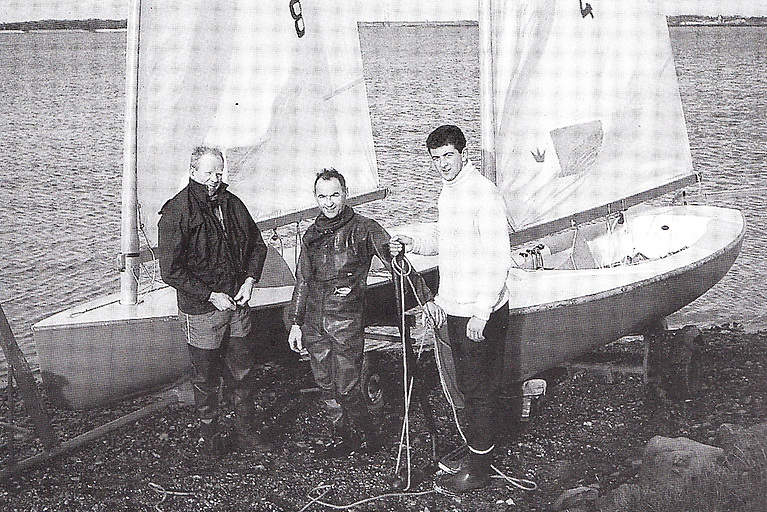 Sean Flood, Neville Maguire and Richard Burrows at Malahide in 1965, when they were regular contenders in the Olympic Finn Class
Sean Flood, Neville Maguire and Richard Burrows at Malahide in 1965, when they were regular contenders in the Olympic Finn Class
His zest in boats and sailing has been transferred down the generations, most notably through his son Des and granddaughter Tara, and he has also inspired many others in boats through his wide circle of friends and shipmates. They join us in wishing a very happy 90th Birthday and warmest congratulations and salutations to Sean Flood.
 At the Asgard-to-Howth Centenary in 2014, Sean Flood with HYC Commodore Brian Turvey (right) and Lisa Turvey (left)
At the Asgard-to-Howth Centenary in 2014, Sean Flood with HYC Commodore Brian Turvey (right) and Lisa Turvey (left)
A New Tall Ship For Ireland? It's Back to The Future
#tallship – The Tall Ships return to Ireland in spectacular style this summer with a major fleet assembly in Belfast from Thursday 2nd to Sunday 5th July for the beginning of the season's Tall Ships Races, organised by Sail Training International. The seagoing programme will have a strong Scandinavian emphasis in 2015, with the route - some of which is racing, other sections at your own speed – starting from Belfast to go on Aalesund in western Norway for 16th to 18th July, thence to Kristiansand (25th to 28th July), which is immediately east of Norway's south point, and then on to conclude at Aalborg in northern Denmark from 1st to 4th August.
But before leaving Northern Ireland with the potentially very spectacular Parade of Sail down Belfast Lough on Sunday July 5th, the celebrations will be mighty. The fleet's visit will be the central part of the Lidl Belfast Titanic Maritime Festival, which will include everything from popular family fun happenings with concerts and fireworks displays – the full works, in other words – right up to high–powered corporate entertainment attractions.
As for the ships, there will be more than enough for any traditional rig and tall ship enthusiast to spend a week drooling over. In all, as many as eighty vessels of all sizes are expected. But more importantly, at least twenty of them will be serious Tall Ships, proper Class A square riggers of at least 40 metres in length, which is double the number which took part in their last visit to Belfast, back in 2009.
That smaller fleet of six years ago seemed decidedly spectacular to most of us at the time. So the vision of a doubling of proper Tall Ship numbers in Belfast Harbour is something we can only begin to imagine. But when you've a fleet which will include Class A ships of the calibre of the new Alexander von Humboldt from Germany, Norway's two beauties Christian Radich and Sorlandet, the much-loved Europa from the Netherlands, George Stage from Denmark, and the extraordinary Shtandart from Russia which is a re-creation of an 18th Century vessel built for Emperor Peter the Great, you're only starting, as that's to name only six vessels – what we'll be seeing will be a truly rare gathering of the crème de la creme.
So although it would be stretching it to think that a small country like Ireland should aspire to having a major full-rigged vessel, we mustn't forget that for 27 glorious years we did have our own much-admired miniature Tall Ship, the gallant 84–ft brigantine Asgard II. Six-and-a-half years years after her loss, it's time and more for her to be replaced. W M Nixon takes a look at what's been going on behind the scenes in the world of sail training in Ireland and finds that, in the end, we may find ourselves with a ship which will look very like a concept first aired for Irish sail training way back in 1954.
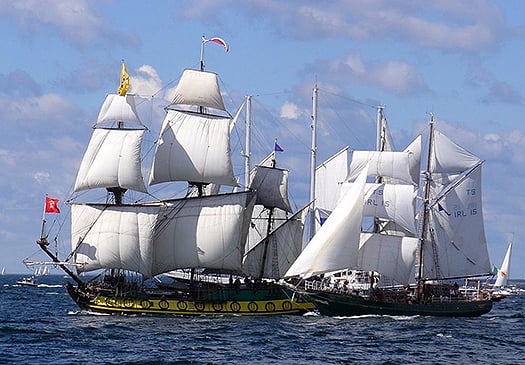
The pain of it. You search out a photo of Shtandart, the remarkable Russian re-creation of an 18th century ship, and you find that Asgard II is sailing beside her
It was while sourcing a photo of Russia's unusual sail training ship Shtandart that the pain of the loss of Asgard II emerged again. It's always there, just below the surface. But it's usually kept in place by the thought that we have to move on, that worse things happened during the grim years of Ireland plunging ever deeper into recession, and that while our beloved ship did indeed sink, no lives were loss and her abandonment was carried out in an exercise of exemplary seamanship.
Yet up came the photo of the Shtandard, and there right beside her was Asgard II, sailing merrily along on what's probably the Baltic, and flying the flag for Ireland with her usual grace and charm. The pain of seeing her doing what she did best really was intense. She is much mourned by everyone who knew her, and particularly those who crewed aboard her. All three of my sons sailed on her as trainees, they all had themselves a great time, and two of them enjoyed it so much they repeated the experience and both became Watch Leaders. It was very gratifying to find afterwards, when you went out into the big wide world and put "Watch Leader Asgard II" on your CV, that it counted for something significant in international seafaring terms.
But as a sailing family with other boat options to fall back on, we didn't feel Asgard II's loss nearly as acutely as those country folk for whom the ship provided the only access to the exciting new world of life on the high seas.

Elaine Byrne vividly recalls how much she appreciated sailing on Asgard II, and how she and her siblings, growing up in the depths of rural Ireland, came to regard the experience of sailing as a trainee on the ship as a "Rite of Passage" through young adulthood
The noted international investigative researcher, academic and journalist Dr Elaine Byrne is from the Carlow/Wicklow border, the oldest of seven children in a farming family where the household income is augmented with a funeral undertaking business attached to a pub in which she still occasionally works. Thus her background is just about as far as it's possible to be from Ireland's limited maritime community. Yet thanks to Asgard II, she was able to take a step into the unknown world of the high seas as a trainee on board, and liked it so much that over the years she spent two months in all aboard Asgard II, graduating through the Watch Leader scheme and sailing in the Tall Ships programmes of races and cruises-in-company
Down in the depths of the country, her new experiences changed the Byrne family's perceptions of seafaring. Elaine Byrne writes:
"Four of my siblings (then) had the opportunity to sail on Asgard II. If it were not for Asgard II, my family would never have had the chance to sail, as we did not live near the sea, nor had the financial resources to do so. The Asgard II played a large role in our family life as it became a Rite of Passage to sail on board her. My two youngest siblings did not sail on the Asgard II because she sank, which they much regret".
She continues: "Apart from the discipline of sailing and the adventure of new experiences and countries, the Asgard brought people of different social class and background together. There are few experiences which can achieve so much during the formative years of young adulthood"
That's it from the heart – and from the heart of the country too, from l'Irlande profonde. So, as the economy starts to pick up again, when you've heard the real meaning of Asgard II expressed so directly then it's time to expect some proper tall ship action for Ireland in the near future. But it's not going to be a simple business. So maybe we should take quick canter through the convoluted story of how Asgard II came into being, in the realization that in its way, creating her successor is proving to be every bit as complex.
As we shall see, the story actually goes back earlier, but we'll begin in 1961 when Erskine Childers's historic 1905-built 51ft ketch Asgard was bought and brought back by the Irish government under some effective public pressure. It was assumed that a vessel of this size – quite a large yacht by the Irish standards of the time – would make an ideal sail training vessel and floating ambassador. It was equally assumed that the Naval Service would be happy to run her. But apart from keen sailing enthusiasts in the Naval Reserve - people like Lt Buddy Thompson and Lt Sean Flood – the Naval Service had enough on its plate with restricted budgets and ageing ships for their primary purpose of fishery patrol.
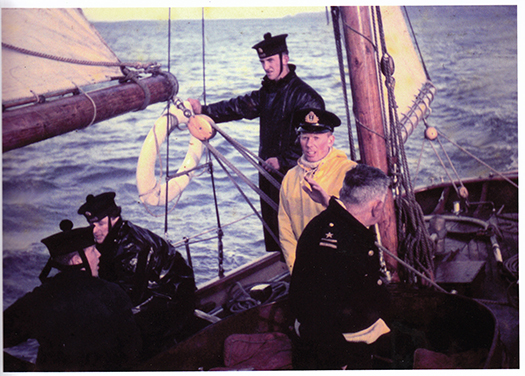
Aboard the first Asgard in 1961 during her brief period in the 1960s as a sail training vessel with the Naval Service – Lt Sean Flood is at the helm
So Asgard was increasingly neglected throughout the 1960s until Charlie Haughey, the new Minister for Finance and the only member of Government with the slightest interest in the sea, was persuaded by the sailing community that Asgard could become a viable sail training ship. In 1968 she was removed from the remit of the Department for Defence into the hands of some rather bewildered officials in the Department for Finance, and a voluntary committee of five experienced sailing people - Coiste an Asgard - was set up to oversee her conversion for sail training use in the boatyard at Malahide, which just happened to be rather less than a million miles from the Minister's constituency.
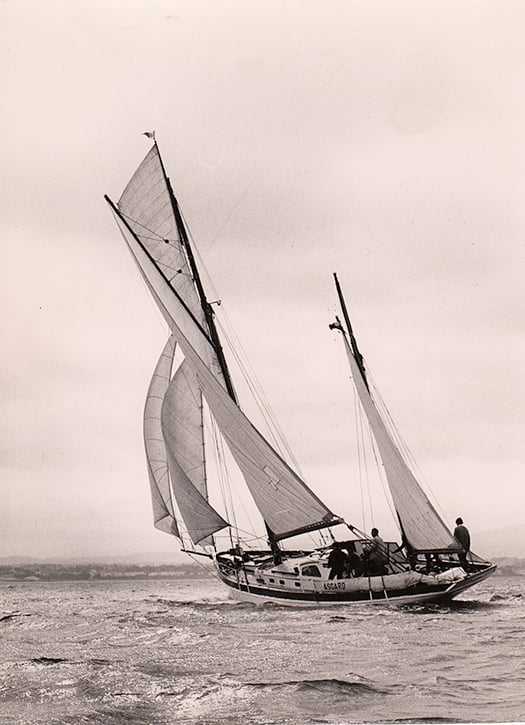
Asgard in her full sail training role in 1970 in Dublin Bay
Asgard was commissioned in her new role in Howth, the scene of her historic gun running in 1914, in the spring of 1969. Under the dedicated command of Captain Eric Healy, the little ship did her very best, but it soon became obvious that her days of active use would be limited by reasons of age, and anyway she was too small to be used for the important sail training vessel roles of providing space to entertain local bigwigs and decision-makers in blazers.
By 1972, the need for a replacement vessel was a matter of growing debate in the sailing community, and during a cruise in West Cork in the summer of 1972, I got talking to Dermot Kennedy of Baltimore out on Cape Clear. Dermot was the man who introduced Glenans to Ireland in 1969, and then he branched out on his own in sail training schools. A man of firm opinions, he reacted with derision to my suggestion that Asgard's replacement should be a modern glassfibre Bermudan ketch, but with enough sails to keep half a dozen trainees busy.
"Nonsense" snorted Dermot. "Ireland needs a real sailing ship, a miniature tall ship maybe, but still a real ship, big enough to carry square rig and have a proper clipper bow and capture the imagination and pride of every Irish person who sets eyes on her. And she should be painted dark green just to show she's the Irish sail training ship, and no doubt about it".
Some time that winter I simply mentioned his suggestions in Afloat magazine, and during the Christmas holidays they were read by Jack Tyrrell at his home in Arklow. During his boyhood, in the school holidays he had sailed with his uncle on the Arklow schooner Lady of Avenel, and it had so shaped his development into the man who was capable of running Ireland's most successful boatyard that he had long dreamed of a modern version of the Lady of Avenel to be Ireland's sail training ship.
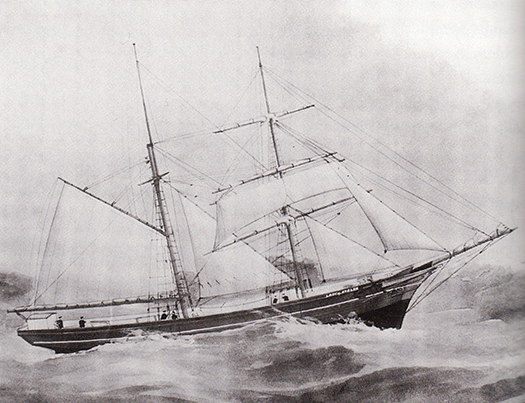
The inspiration – Jack Tyrrell's boyhood experiences aboard Lady of Avenel inspired him to create Ireland's first proper sail training ship
In fact, in 1954 he had sketched out the plans for a 110ft three masted training ship, but Ireland in the 1950s was in the doldrums and the idea got nowhere. Yet the spark was always there, and it was mightily re-kindled by what Dermot Kennedy had said. So at that precise moment, the normal Christmas festivities in the Tyrrell household were over. They'd to continue the celebrations without the head of the family. The great man took himself off down to the little design office in his riverside boatyard, and in clouds of pipe tobacco smoke, he re-drew the lines of the 110ft three master to become an 83ft brigantine, the size reduction meaning that the shop would only need a fulltime crew of five.
Working all hours, he had the proposal drawings finished in time to rejoin his family to see in the New Year. And in the first post after the holiday, we got the drawings at Afloat, and ran them in the February 1973 issue.
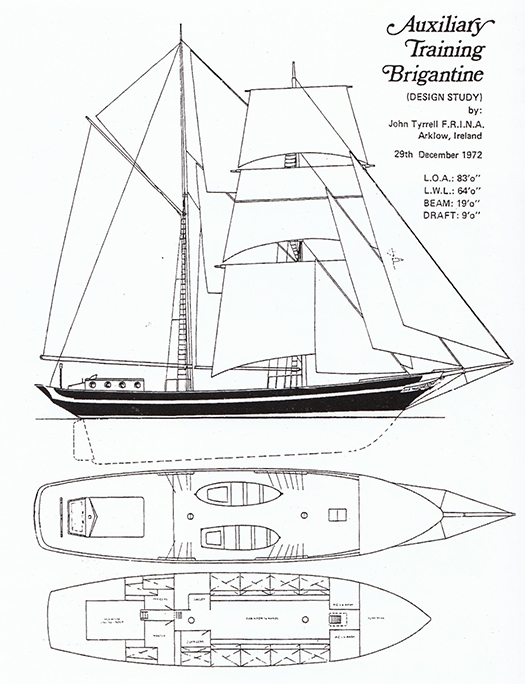
Jack Tyrrell's proposal drawings for the new brigantine, as published in the February 1973 Afloat
In Ireland then as now, most politicians had inscribed in their heads the motto: "There's No Votes In Boats". So after Charlie Haughey had fallen from favour with the Arms Trial of 1970, Coiste an Asgard became an orphan. But 1973 brought a new government, and there was one cabinet minister in it who was proud to proclaim his allegiance to the sea.
Unfortunately for the respectability of the maritime movement in Ireland, our supporters in the higher echelons of politics have often tended to be from the colourful end of the political spectrum, whatever about their placing in the left-right continuum. Thus it was that, at mid-morning on St Patrick's Day 1973, I got an ebullient phone call and an immediate announcement, without the caller saying who he was. "Winkie" he bellowed, "That ship is going to be built. I'll make sure of it. I've just made a ministerial decision".
It emerged that it was our very own new Minister for Defence, Patrick Sarsfield Donegan TD. The enthusiasm for the new ship, engendered by studying Jack Tyrrell's drawings, led to a snap decision which stayed decided, and it all happened in the Department for Defence.
However, it was 1981 by the time the ship was launched, and she looked rather different from Jack Tyrrell's preliminary drawings, though the basic hull shape built in timber was the same sweet lines as originally envisaged, so she was able to sail like a witch. But as for her supporters at Government level, the non-stop cabaret continued. Charlie Haughey had regained power, and by 1981 he was Taoiseach. It was he who had seen to it that the Department of Defence continued to look after the Asgard II project with support from another sailing TD who might not have seen eye–to-eye with him on other matters, Bobby Molloy of Galway.
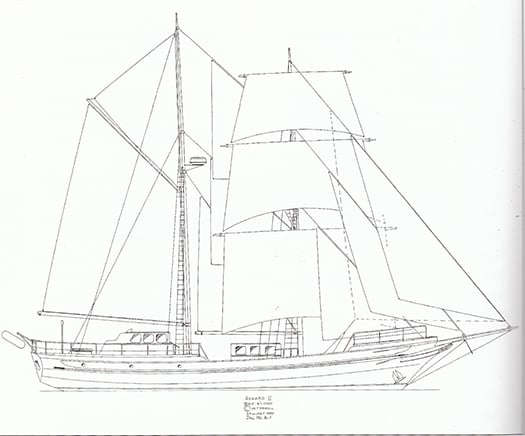
Asgard II in her finished form
So on a March day in 1981, almost exactly twelve years after he'd commissioned the original Asgard in her new role as a sail training vessel, Charlie Haughey took it upon himself to christen the new Asgard II in Arklow basin. And the champagne bottle refused to break. Five or six time he tried, but with no success.
Showing considerable grace under pressure and observed by a large crowd, he quietly took his time undoing all the ribbons and paraphernalia on the big bottle. Then he marched with it up to the new flagship's stem, and hit it a mighty double-handed wallop. The bottle exploded that time, with no mistake. And apart from the usual Haughey growl to those nearby about the idiocy of whoever forgot to score the champagne bottle beforehand, it was all done with the best of humour.
For most of her subsequent career, there's no doubt Asgard was a lucky and very successful vessel. Yet when her demise came, you couldn't help but think of the old notion that if the champagne bottle doesn't break first time, then she'll ultimately be an unlucky ship.
But there are more prosaic explanations. With a limited budget and every penny being scrutinized, Jack Tyrrell and his men had to build Asgard II in fishing boat style, which is fine within its proper time span, but that time span is really only twenty years, maybe thirty if the ship gets extra care. But with her fishing boat hull carrying a demanding brigantine rig, although she always looked immaculate, Asgard II was starting to show her age in the stress areas.
By 2005 there was serious talk about the need to plan for a replacement. When her skipper Colm Newport was told to renew her rig as the original spars were clearly well past it, he meticulously searched the best timber yards at home and abroad and when she got her new rig – it was 2006 or thereabouts – I wrote an only slightly tongue-in-cheek article suggesting that now was the time to replace her old tired wooden hull with a new steel one to the same Jack Tyrrell lines, but utilising the excellent new rig and as many of the fixtures and fittings as were still in good order from the original ship.
To say the response was negative is understating the case. People's attachment to Asgard could only imagine a wooden ship. It was the end of any meaningful debate. So things drifted on, with each new government seemingly even less interested in maritime matters generally, and sail training in particular, than the one before.
In September 2008, Asgard started taking in water while on passage with a crew of trainees towards La Rochelle for a maritime festival following which - while still in La Rochelle – it was planned that she would be lifted out for a thorough three week survey and maintenance programme.

Asgard's accommodation worked superbly whether at sea or in port. But the fact that so much was packed into a relatively small hull meant that some areas were almost inaccessible for proper inspection
It might have been the saving of her. But it was not to be. It's said that it was a failed seacock which caused the catastrophic ingress of water. She was a very crowded little ship, she packed a lot into her 84ft, so some hull fittings were less accessible internally than they would be in a more modern vessel, and may have deteriorated to a dangerous level. But if, as some would propose, she hit something in the water which caused a plank to start, then the fact that nobody aboard was aware of any impact suggests that the time for a major overhaul, and preferably a hull replacement, was long overdue.
The moment Asgard II sank, she ceased to have any future as a sail training vessel, and there was no real official interest in her salvage. You simply cannot take other people's children to sea on a salvaged vessel of doubtful seaworthiness. And as it happens, the sinking came at exactly the time the Irish economy fell of a cliff. So although after an enquiry the Government accepted a €3.8 million insurance settlement, in the end, despite assurances to the contrary, it disappeared into the bottomless pit which was the national debt, and within a year Coiste an Asgard was wound up with its records and few resources incorporated into a new entity, Sail Training Ireland.
The plot takes a further macabre twist in that, shortly after the loss of Asgard II, the Northern Ireland Sailing Training ketch was also lost after hitting a rock on the Antrim coast. From having two popular and well-used sail training vessels in the middle of 2008, within a year Ireland had no official sail training vessels at all.
Yet though the flame had been largely subdued, there were those who have kept the faith, and gradually the sail training movement is being rebuilt. Sail Training Ireland is the frontline representative for around five different organisations, being the official affiliate of Sail Training International, and it has a busy programme of placing trainees in ships which operate at an international level, in which the Dutch are supreme.
In Ireland at the moment, the only sail training "ship" is the schooner Spirit of Oysterhaven, run by Oliver Hart and his team from their adventure centre near Kinsale. In fact, Spirit – you can read about her in Theo Dorgan's evocative book Sailing For Home (Penguin Ireland 2004) – really is punching way above her weight in representing Ireland in a style reminiscent of both the Asgards.
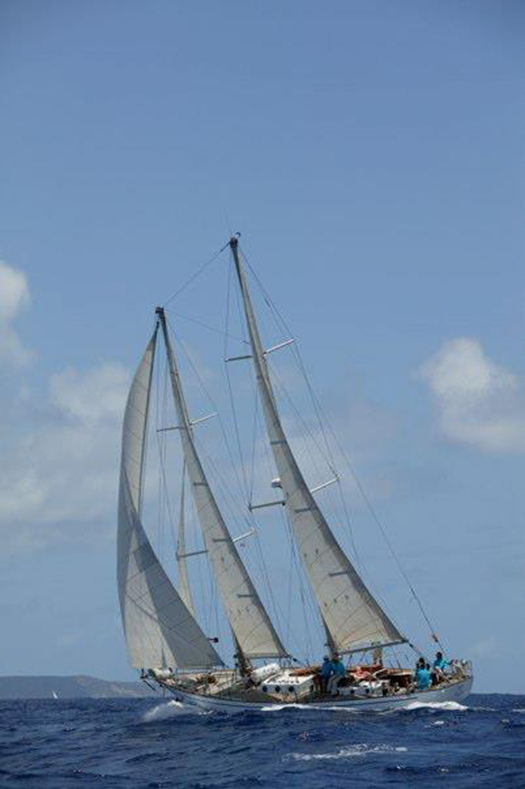
Spirit of Oysterhaven has been doing great work in keeping sail training alive in Ireland
But having the ship is one thing, paying the fees for the trainees to be aboard is something else, and sail training bursaries are one of the key areas of expansion in current maritime development in Ireland. There was an unusual turn to this in 2014 when somebody came up with the bright idea of using Irish Cruising Club funds (which are generated by the surplus from the voluntary production of the club's Sailing Directions) to provide bursaries for youngsters to take part in last summer's ICC 85th Anniversary Cruise-in-Company along the southwestern seaboard on Spirit of Oysterhaven.
The idea worked brilliantly, and this concept of neatly-tailored sail training bursaries is clearly one which can be usefully developed. But still and all, while it's great that young Irish people are being assisted in getting berths aboard charismatic vessels like Europa, the feeling that we should have our own proper sail training ship again is gradually gaining traction, and this is where the Atlantic Youth Trust comes in.
The AYT had its inaugural general meeting in Belfast as recently as the end of September 2014, so it may not yet have come up on your radar. But as it has emerged out of the Pride of Ireland Trust which in turn emerged from the Pride of Galway Trust, you'll have guessed that Enda O'Coineen and John Killeen are much involved, and they've roped in some seriously heavy hitters from both sides of the border, either as Board Members or backers, and sometimes as both.
The cross-border element is central to the concept of building a 40 metre three-masted barquentine, a size which would put her among the glamour girls in Class A, and could carry a decidedly large complement of 40 trainees, even if you're inevitably talking of stratospheric professional crewing costs.
However, by going straight in at top government level on both sides of the border, the AYT team are finding that they're pushing at a door which wants to open, particularly after the new Stormont House agreement was reached in the last days of 2014 to bring a more enthusiastic approach both to cross-community initiatives in the north, and cross border co-operation generally.
Who knows, but if they can succeed in getting cross-community initiatives working in Northern Ireland, then they may even be able to swing some sort of genuine Dublin-Cork shared enthusiasm in the Republic, for I've long thought that one of the factors in holding back many maritime initiatives in Ireland is that, while Dublin may be the political capital, Cork is quietly confident it's the real maritime capital, and does its own thing.
Be that as it may, the AYT have done serious studies, and their conclusion is the best scheme to learn from is the Spirit of Adventure programme in New Zealand. This is where the feeling of going back to the future arises, for in looking at photos of their ship Spirit of New Zealand, there's no escaping the thought that you're looking at Jack Tyrrell's concept ship of 1954 brought superbly to life.
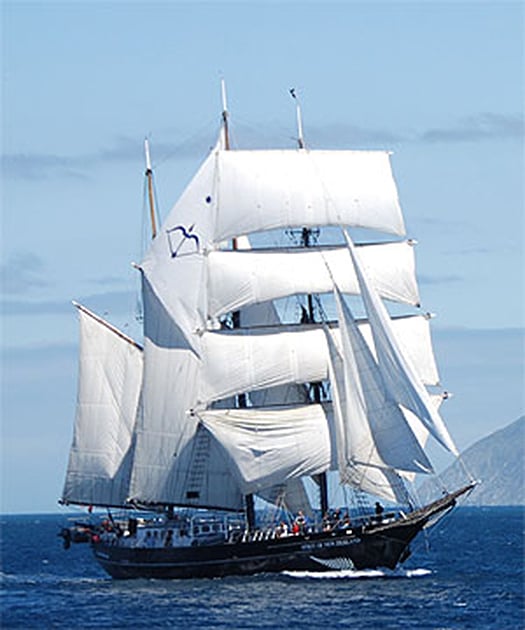
Spirit of New Zealand

Spirit of New Zealand almost seems like a vision of 1954 brought to life...

.....and that vision is Jack Tyrrell's 1954 concept for a 110ft sail training ship
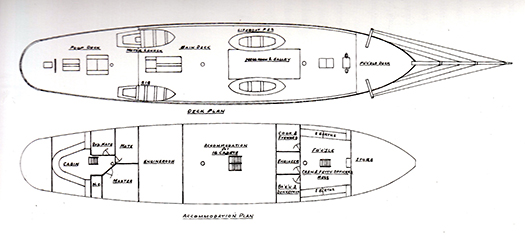
The 1954 accommodation drawings for the 110ft ship hark back to a more rugged age. Imagine the difficulties the ship's cook would face trying to get hot food from his galley on deck amidships all the way back to the officers in their mess down aft
We needn't necessarily agree with all the AYT's basic thinking For instance, they assert that Ireland is like New Zealand is being an isolated smallish island. It depends what you mean by "isolated". Those early sail training pioneers, the Vikings, certainly didn't think of Ireland as isolated. They thought it was central to the entire business of sailing up and down Europe's coastline.
Thus any all-Ireland sail training vessel would be expected to be away abroad at least as much as she'd be at home, whereas Spirit of New Zealand is usually home – the season of 2013-2014 was the first time she'd been to Australia since 1988, when she was in the fleet with Asgard II for the First Feet celebrations.
In New Zealand, she's a sort of floating adventure centre, and a large tender often accompanies her to take the trainees to the nearest landing place for shoreside adventures, for it's quite a challenge keeping 40 energetic young people fully occupied.
In Europe, that's where the sail training races come in. Time was when the racing aspect was down-played. But there's nothing like a good race to bring a mutinous crew together, and the recently-published mega-book about the world's sail training vessels, Tall Ships Today by Nigel Rowe of Sail Training International, quite rightly devotes significant space to everything to do with the racing.
Thus if we do get a new sail training ship for Ireland, she'll have to sail well and fast. That was Asgard II's greatest virtue. For there is nothing more dispiriting for troubled young folk than to find themselves shackled to the woofer of the fleet. Yet you'd be pleasantly surprised by how previously disengaged youngster can become actively and enthusiastically involved when they find that they're being transformed from scared and seasick kids into members of a winning crew.
So now, the 64 thousand dollar question. The cost. It's rather more than 64 thousand. AYT reckon they'll have to come up with a final capital expenditure of €15 million to build the ship and get her into full commission with proper crewing and shoreside administration arrangements in place. But after that – and here's the kernel of the whole concept – they reckon that the running costs will come out of existing government expenditure already in place and used every year for education, youth training, sporting facilities, social development and so forth.
So their pitch is that if the governments north and south come up with funding to support substantial donations already proposed for AYT by various benevolent national and international bodies, then once the ship is in being, she will generate her own income in the same way as vessels like Europa and Morgen Stern are already doing in mainland Europe.
And it's to the heart of mainland Europe that they'll be looking for design and contruction, as it's the Dykstra partnership which will be overseeing the design, and their ship-build associate company Damen will likely do the construction work, though one idea being floated is that Damen might provide a flatpack kit for the vessel to be built in steel in Ireland.
Those of us who dream of Asgard II being built anew will find all this a bit challenging to take on board. My own hopes, for instance, would still be to build Asgard II again to Jack Tyrrell's lines, but with the hull constructed in aluminium. It would be expensive as it would need to be double-skin below the waterline, but the ship's size would be very manageable with a professional crew of just five, while she'd sail like a dream And proper top-class marine grade aluminium seems to last for ever, as naval architect Gerry Dijkstra (his surname is slightly different from that of the partnership) himself shows with his remarkable cruises with his own-designed alloy 54-footer Bestevaer.
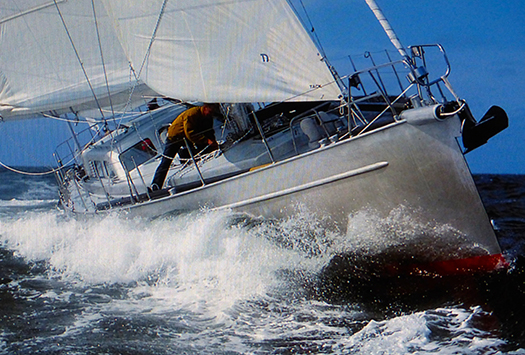
A man who knows what he's doing. This is Gerry Dijkstra's own extensively-cruised alloy-built 54 footer Bestevaer. The name translates not as "Best ever", but either as "best father" or "best seafarer", and was the name of affection given to the great Admiral de Ruyter by his loyal crews
Whatever, the good news is that things are on the move, and we wish them well, all those who have kept the Irish sail training flame alive through some appalling setbacks. Now, it really is the time to move forward. And if we do get a new ship, why not call her the Jack Tyrrell? He, of all people, was the one who kept the faith and the flame alive.
- Tall ship
- Belfast
- Jack Tyrell
- Kristiansand
- Aalesund
- Titanic
- maritime
- Class A
- square riggers
- George Stage
- Alexander Von Humboldt
- Christian Radich
- Sorlandet
- Shtandart
- Brigantine
- Asgard II
- Elaine Byrne
- Erskine Childers
- Sean Flood
- Naval
- Afloat magazine
- boatyard
- sail training ship
- Coiste an Asgard
- Charlie Haughey
- Colm Newport
- Irish Cruising Club
- Spirit of Oysterhaven
- Enda O'Coineen
- John Killeen
- Dykstra
The Celtic Mist, the new flagship of the Irish Whale and Dolphin Group, was berthed in Waterford city for the Tall Ships weekend writes Shay Fennelly. Gifted to the IWDG in May 2011 by the family of a former Irish Prime Minister, Charles Haughey, who declared Irish waters a whale and dolphin sanctuary in 1991.
Celtic Mist left Waterford on Sunday morning in glorious sunshine on passage down the River Suir for the Tall Ships Parade of Sail off Dunmore East watched by thousands of people from the river bank at Passage east, Duncannon and Dunmore East.
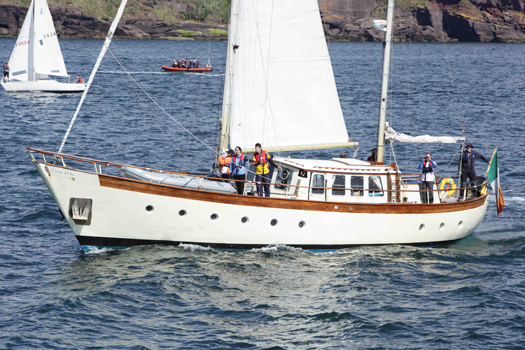
Ireland's only entry in the 2011 Tall Ships race from Waterford to Greenock Irish Whale and Dolphin Groups's research vessel Celtic Mist in the Tall Ships Parade of Sail off Dunmore East in Waterford. Photo: Shay Fennelly/Aquaphoto
The Tall Ships fleet was reviewed by Flag Officer Commanding Naval Service Commodore Mark Mellet and Sean Flood Sail Training Ireland (Board) and a Goodwill Ambassador for Sail Training International past the LE Aoife. Over 1200 young people, many who have never been to sea before, are onboard the 50 tall Ships sailing to Greenock.
On board Celtic Mist are Captain Fiacc Brolchain, Gary Davis, Eithne Griffith, Deirdre Slevin, Conor Ryan and trainees Siobhan Ardener (19) from Killarney, Co Kerry, and Keith Cleere (19) from New Ross, Co Wexford.
The race started slowly at 15.00hrs, five miles south of the Hook Lighthouse in 10 knots of wind and blue skies and headed for the Irish Sea to Scotland.
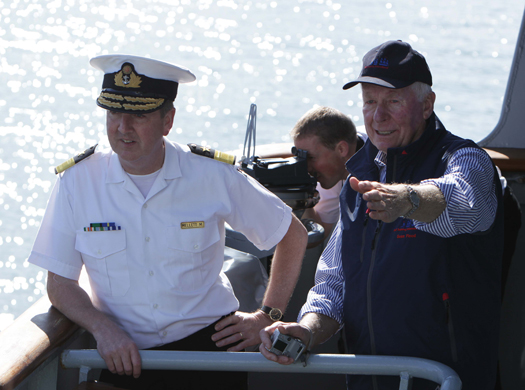
Flag Officer Commanding Naval Service, Commodore Mark Mellet (left) and Sean Flood Sail Training Ireland (Board) and a Goodwill Ambassador for Sail Training International on board LE Aoife reviewing the Tall Ships fleet as they passed off Dunmore East, County Waterford. Photo: Shay Fennelly/Aquaphoto
Sheila Tyrrell to Chair New Sail Training Group
The new umbrella organisation Sail Training Ireland includes a number of key sailing people involved in sail training in Ireland including the chief executive of the Irish Sailing Association Harry Hermon and Seamus McLoughlin the head of operations of Dublin Port Company. The group also includes Kalanne O'Leary, a former member of Coiste an Asgard, the state board that ran Asgard II. The full group, chaired by Sheila Tyrrell, has been named as follows:
Sheila Tyrrell, Chair
Harry Hermon, ISA Chief Executive
Philip Cowman ISA Director, Ex Harbour Master Waterford
Kalanne O'Leary, Irish Representative on Sail Training International
Seamus McLoughlin, Head of Operations, Dublin Port
Sean Flood, Sail Training International Ambassador – Ireland.
Looking for further reading on Tall Ships in Ireland? Click the links below:
Click this link to read all our Tall Ships Stories on one handy page
Previewing Ireland's Tall Ships 2011 Season
Can Ireland Get a New Tall Ship?





























